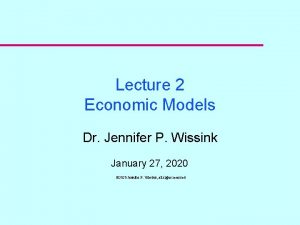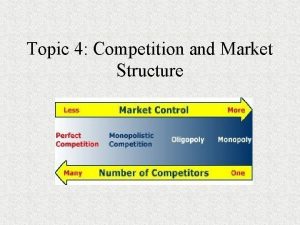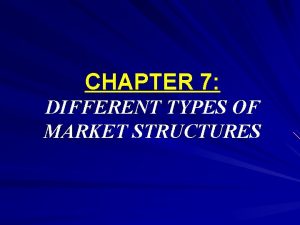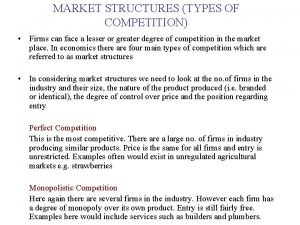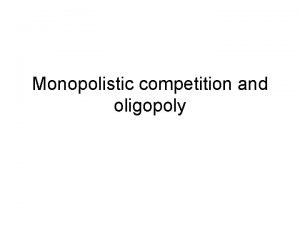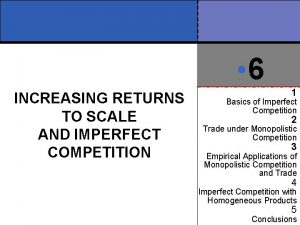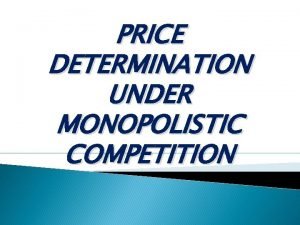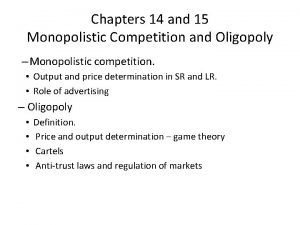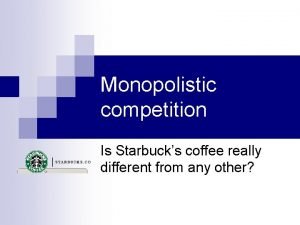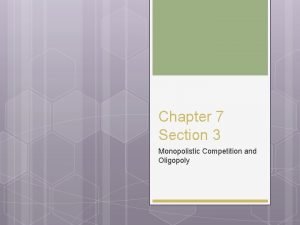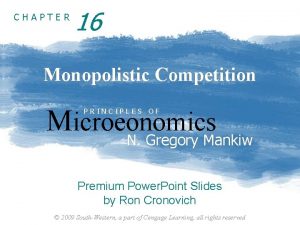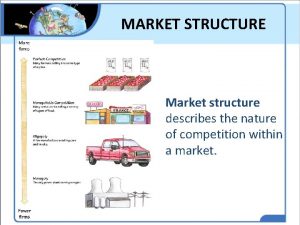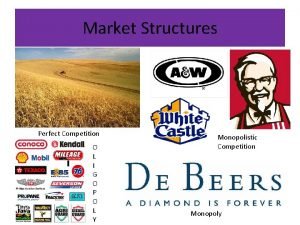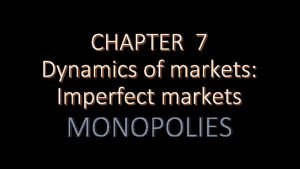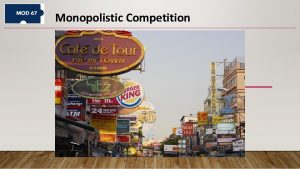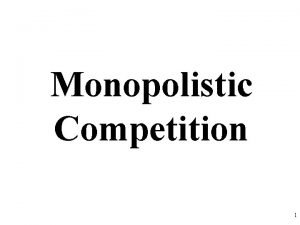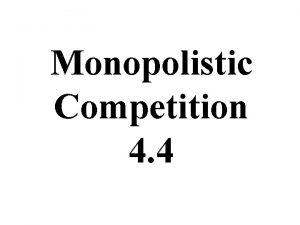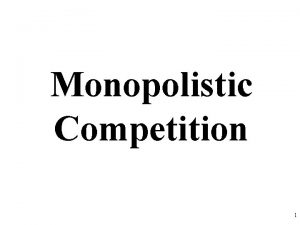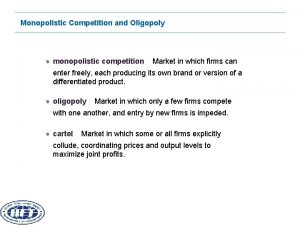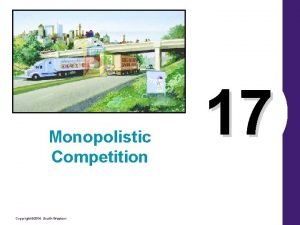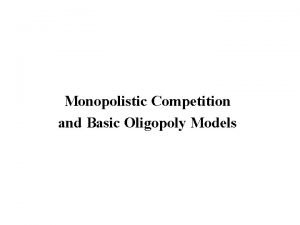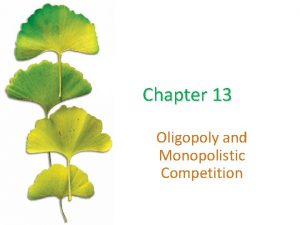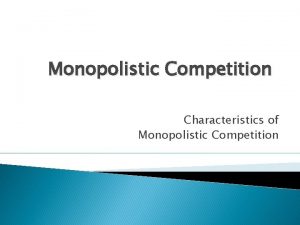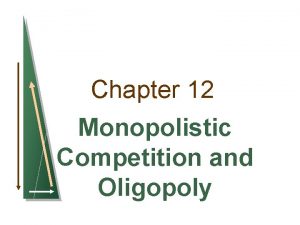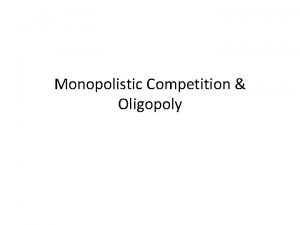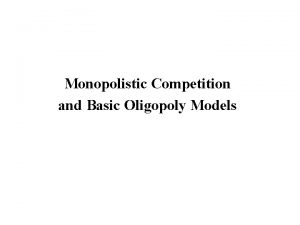Monopolistic Competition Lecture 25 Dr Jennifer P Wissink






















- Slides: 22

Monopolistic Competition Lecture 25 Dr. Jennifer P. Wissink © 2017 John M. Abowd and Jennifer P. Wissink, all rights reserved. May 3, 2017


Using Multiple Two Part Tariffs to Price Discriminate u Suppose two types of cell phone users: identical old ladies and identical college kids – Assume college kids get loads more surplus from using their minutes than old ladies do. u Consider cell phone plans – Perfect/1 st degree price discrimination via a multiple two-part tariff pricing scheme » » » Set one common price/per minute at $mc $P=$mc. Set monthly fee to each college kid = $Fee. CK = $CSCK. Set monthly fee to each old lady = $Fee. OL=$CSOL. Note: $Fee. CK > $Fee. OL Best case scenario for monopolist. Would be equivalent to perfect/1 st degree price discrimination, but a heck of a lot easier to implement. » But. . . will it work?

Using Multiple Two Part Tariffs to Price Discriminate u u Nope! Perfect Price Discrimination FAILS. – College kids will want to “pretend” they are old ladies. – That way they get charged the lower entry fee!

Using Multiple Two Part Tariffs to Price Discriminate u IMperfect Price Discrimination via twopart tariff pricing schemes $ amount you pay Plan A: slope=$. 25 Plan B: slope=$. 05 PLAN A: Monthly Fee=$20, and then you pay 25¢ per minute PLAN B: Monthly Fee=$100, and then you pay 5¢ per minute u Can get a “separating equilibrium” with “self selection”. $100 $20 # minutes

Moving On… Monopolistic Competition: Structure u Structure: – – u Several firms in the market. Firms produce differentiated products. “Free” entry and exit. Full and symmetric information. Re: Differentiated Products – Actual: taste, color, location, service, etc. – Perceived: lei jeans vs. Wranglers! u Intellectual “Parents” – Joan Robinson (economist at Cambridge in the U. K. ) – Edward Chamberlin (economist at Harvard in Cambridge, MA) – Both pioneered the work on monopolistic competition in the early 1930’s. u “The purpose of studying economics is not to acquire a set of ready-made answers to economic questions, but to learn how to avoid being deceived by economists. ”

Monopolistic Competition: Short Run Conduct u Looks and acts just like a mini-simple-monopolist. srmc $ sratc PMC atc. MC demand for GV Jeans q. MC q mr

Monopolistic Competition: Long Run Conduct u Free entry will force firm long run economic profits to zero. $ lratc lrmc u So at qmc need: – 1) profit max and – 2) zero profit and – 3) a downward sloping firm demand corresponding marginal revenue. u Firm’s demand curve will be tangent to its long run average total cost curve. PMC demand for GV jeans q q. MC mr

Monopolistic Competition: Performance (Efficiency & Equity) u i>clicker question Is the monopolistically competitive firm Pareto/Allocatively Efficient (AE)? A. Yes. B. No. C. Maybe so u i>clicker question Is the monopolistically competitive firm productively efficient (pe)? A. Yes. B. No. C. Maybe so

Up Next: Oligopoly

Oligopoly: Structure Competition Among A Few u u In an oligopoly there are very few sellers of the good. The product may be differentiated among the sellers (e. g. automobiles) or homogeneous (e. g. gasoline). Entry is often limited either by legal restrictions (e. g. banking in most of the world) or by a very large minimum efficient scale (e. g. overnight mail service) or by strategic behavior. Sill assuming complete and full information.

Oligopoly: Conduct u Harder to model! (Compared to perfect competition and monopoly and monopolistic competition) u In an oligopoly – firms know that there are only a few large competitors – competitors take account of the effects of their actions on the market u To predict the outcome of such a market, economists frequently use game theory methods.

Game Theory: Setup u u u u List of players: all the players are specified in advance. List of actions: all the actions each player can take are spelled out. Rules of play: who moves and when is spelled out. Information structure: who knows what and when is spelled out. Strategies: the set of actions players can use. Payoffs: the amount each player gets for every possible combination of the players’ strategies. Solution or equilibrium concept: a way you reason that players select strategies to play, and then consequently how you predict the outcome of the game.

Dominant Strategy Equilibrium u u A Dominant Strategy for player “i” is a strategy such that player’s i’s payoff from playing that strategy is at least as large as the payoff player i would get from playing any other strategy, no matter what player i’s rivals choose as their strategies. A Dominant Strategy Equilibrium of a game occurs when each player of the game has and plays his/her dominant strategy. Lots of interesting games have dominant strategy equilibriums. And for lots of interesting and fun games DON’T.

The Prisoners’ Dilemma Game & Dominant Strategy Equilibrium u Roger and Chris have been accused of a major crime (which they committed). – They also have outstanding warrants based on minor crimes, too. u u u They are held in isolated cells and offered the choice to either Lie or Confess. The payoff matrix shows the number of years of prison Roger (the row player) and Chris (the column player) will receive depending upon who confesses and who lies as (Roger’s prison time, Chris’ prison time). The game is played one-shot, simultaneously and non-cooperatively with full information.

The Prisoners’ Dilemma Is Very Distressing. . . , Or Is It? u u u In the Prisoners’ Dilemma game, the “superior” outcome is when both prisoners lie – but that requires cooperation. When the game is only played once, simultaneously and non-cooperatively, (confess, confess) is the dominant strategy equilibrium and (-5, -5) is the dominant strategy equilibrium outcome. Could Roger & Chris sustain the (lie, lie) outcome of (-1, -1) somehow? – change the payoffs in the matrix – play the game repeatedly u Do all games have at least one dominant strategy equilibrium? – NO! – Then what?

Nash Equilibrium u Named after John Nash - a Nobel Prize winner in Economics. – Did you read or see A Beautiful Mind? u A Nash Non-cooperative Strategy (Best Response) for player “i” is a strategy such that player’s i’s payoff from playing that strategy is at least as large as the payoff player i would get from playing any other strategy, given the strategies the others are playing. u A Nash Non-cooperative Equilibrium is a set of (Nash) strategies for all players, such that, when played simultaneously, they have the property that no player can improve his payoff by playing a different strategy, given the strategies the others are playing.

Hotelling's Location Game (Nash Equilibrium in Location)

The Price Game Low Roger High Chris Low High 20, 20 60, 0 0, 60 100, 100 i>clicker question: Are there any dominant strategy equilibria? i>clicker question: Are there any Nash equilibria? A. Yes B. No.

Maximin Equilibrium u u More proactive than reactive. Pessimistic? The “min” part of maximin: for each of his options the player determines his worst outcome(s). The “max” part of maximin: the player then looks over all his worst case scenarios for each strategy and picks the best of the worst. The equilibrium part of maximin: When each player has a maximin strategy and when played against each other they are a Nash equilibrium. – So all maximin equilibria are Nash equilibria. – Not all Nash equilibria are maximin equilibria. Low Roger High Chris Low High 20, 20 60, 0 0, 60 100, 100

Consider the following game between Roger and Chris. It is played one shot, simultaneously and non-cooperatively. CHRIS ROGER Left Right Top 10, 2 22, 2 Middle 20, 20 10, 20 Bottom 10, 5 5, 20 i>clicker question: Is there a dominant strategy equilibrium? i>clicker question: Is there a Nash equilibrium? i>clicker question: Is there a maximin equilibrium? A. Yes B. No

Another Game To Try u u u A B C D 1 10, 20 30, 15 16, 12 2 20, 10 30, 40 20, 25 8, 24 3 20, 20 12, 20 15, 10 25, 29 4 10, 10 15, 24 20, 20 11, 27 Player 1 is the row player and can select numbers. Player 2 is the column player and can select letters. The payoffs are (Player 1, Player 2) Game is one-shot, simultaneous, non-cooperative, full information. Are there any… – Dominant strategy equilibriums? – Nash? – Maximin?
 Pure competition vs monopolistic competition venn diagram
Pure competition vs monopolistic competition venn diagram Perfect competition vs monopolistic competition
Perfect competition vs monopolistic competition Perfect competition vs monopolistic competition
Perfect competition vs monopolistic competition Perfect competition vs monopolistic competition
Perfect competition vs monopolistic competition Jennifer wissink
Jennifer wissink Jennifer wissink
Jennifer wissink Dr jennifer a. baima
Dr jennifer a. baima Difference between monopoly and monopolistic competition
Difference between monopoly and monopolistic competition Monopolistic def
Monopolistic def Shampoo monopolistic competition
Shampoo monopolistic competition Monopolistic competition in long run
Monopolistic competition in long run Monopolistic competition example
Monopolistic competition example Monopolistic competition
Monopolistic competition Mr=mc monopoly
Mr=mc monopoly How is price determined under monopolistic competition
How is price determined under monopolistic competition Barriers of entry for oligopoly
Barriers of entry for oligopoly Is starbucks an oligopoly
Is starbucks an oligopoly Chapter 7 section 3 monopolistic competition and oligopoly
Chapter 7 section 3 monopolistic competition and oligopoly Monopolistic competition characteristics
Monopolistic competition characteristics Market structure
Market structure Example of pure competition
Example of pure competition Price determination under monopolistic competition
Price determination under monopolistic competition Difference between monopoly and perfect competition
Difference between monopoly and perfect competition






